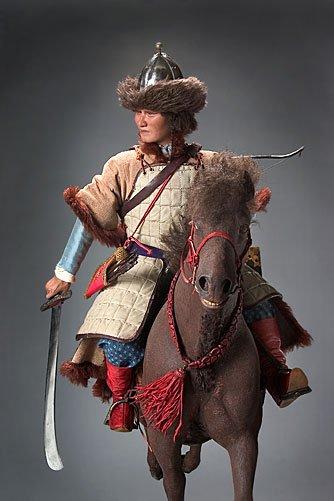A while back we did a post on what the world was like in 1555 A.D. That was a lot of fun and I’ve been watching those awesome “Mankind” shows on the History Channel lately, so how’s about another foray into our spicy past? This time, we’re looking at another great era for the letter F: the 440s – 450s. A.D.
What was happening then? What were we doing? Who was blading and javelin-ing whom? What sorts of fluffy, pointy hats were en vogue? Was America rockin’ it superpower-style? The mighty Atilla the Hun died how?
Come with me as we delve into these dark, dank, kinda’ depressing decades that featured decadence for few, and decapitations for many. We don’t have much patience or relevant expertise room, so we’ll just look at a couple folks who were big at the time and skim some general happenings of the day.
By 440 A.D., the world was changing fast. The glory days of the intellectual Greeks had passed, the Roman Empire had been sliced into Western and Eastern entities and was careening toward its demise in 476 (the debated but generally historically accepted date of its demise), Christianity was on the upswing. Hypatia, history’s earliest female mathematician, had been murdered, Augustine had died, the great Library of Alexandria was no more, and the world’s balance of power seemed to be tilting toward barbaric sorts. Speaking of barbarism, let’s start by discussing that perennial first-round choice in everyone’s Fantasy Bloodthirsty Warlord Draft, Atilla.
Atilla the Hun – Truly one of history’s great purveyors of warfare and wanton bloodshed, Atilla hacked his way through Europe, carving out huge swathes of territory (eventually from what is now modern-day Germany all the way to the area of modern-day Georgia [Tbilisi not Honey Boo Boo/Chipper Jones]) and raking in crazy amounts of tribute along the way. He destroyed cities without mercy and massacred their populations.

Awesome Atilla the Hun figure sporting the pointy, fluffy hat of the day; riding a horse with an emo haircut.
After his brother Bleda died in 445 (some say he died in a hunting accident, while some say Atilla was responsible for his death – who are we kidding, let’s just presume Atilla is guilty here) Atilla became the sole Khan of his vast empire. Though he was defeated in 451 by the fantastically-named Flavius, he continued torturing what was left of the Roman Empire and invading neighbors until his comically unmanly death in 453.
After a feast, he succumbed to what many believe was a… nosebleed*. How appropriate for one of the world’s fiercest warriors to be felled by an ailment that is routinely shrugged off by puny nerds everywhere.
A historian wrote that Atilla’s death should be mourned; not with “feminine lamentations or tears,” but rather with the “blood of men.” On that note, legend has it that after some of his men buried him in an elaborate coffin, they were killed so no one would know exactly where Atilla, “The Scourge of God,” lay.
Not everyone was so bloodthirsty at this time however…
Patrick, AKA Saint Patrick, AKA the revered man of God we celebrate each March by donning green and shaming our families, is believed to have been living during these decades.
St. Patrick – Born in Roman Britain, he was captured, enslaved and taken to Ireland at the age of 16. After six years of slave labor in Ireland, he escaped back home to Britain. Incredibly, he returned to Ireland – the land of his captors – as a Christian missionary. While he probably didn’t drive all the snakes out of Ireland (apparently Ireland didn’t even have snakes at the time; some historians think this is a reference to his driving Pagan symbols out), he did go on to help spread Christianity throughout the island – apparently using the 3-leafed shamrock to help explain the Trinity.
Other Stuff That Was Happening in the 440s – 450s
Making Things – At about this time in the mid-5th Century, some new things were emerging. The Chinese started making good use of the wheelbarrow, and the horseshoe was becoming more commonplace: both of which facilitated agricultural and labor initiatives.
Worrying About Things – There were natural disasters, plagues and plenty of violence for people to worry about.
Exploring, Founding New Things – Legend has it that during this time, Polynesian bigwig Hawaiiloa and a group of intrepid sailors sailed thousands of miles from their home in the South Pacific and managed to reach Hawaii. (Just another early example of Americans goin’ big, punching limitations in the face, and rockin’ it superpower-style).
The awesome city of Chichen Itza was founded in Mexico during this period as well.
Arguing About Religious Things – Christians were trying to reach a consensus on what orthodoxy should be (which phew, thankfully is no longer an issue JK) – Jews were being persecuted, while Daoism and Buddhism vied for dominant religion status in China.
Trying To Get More Things – Atilla and his Huns weren’t the only ones out for more during this time. The Vandals had helped themselves to much of northern Africa and eventually sacked Rome in 455, while in Japan, someone was always trying to usurp this or that emperor.
Let’s just cut it here, that was a lot to take in. Before we leave for the day however, I think it is worth noting how the people, events, and patterns listed above all seem pretty familiar. Despite the events being about 1,600 years old, you can see the parallels in today’s world: we’re still violent, and we still make stuff, explore, argue and try to get more than our fair share… But there are still good people too.
Story of our lives I suppose!
*The assumption is that Atilla drank way too much one night and basically choked on blood. Still a pretty unmanly way to go.
Filed under: F Commentary, Foreign Lands Tagged: Asia, atilla, Christianity, Europe, history, religion, war
